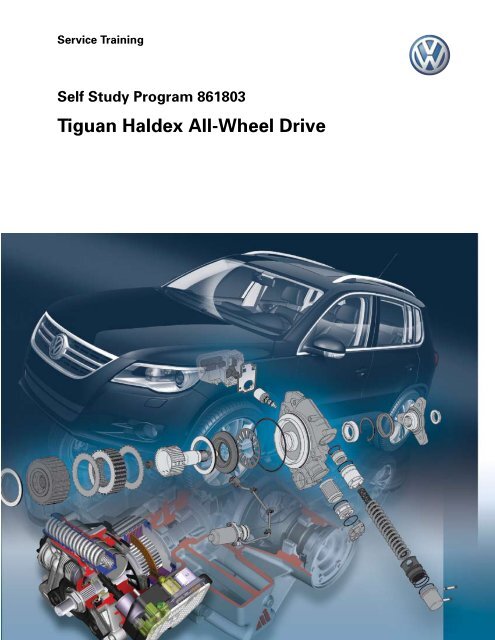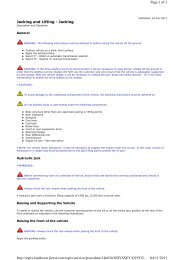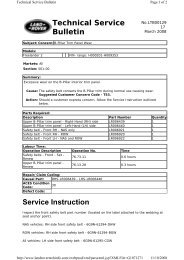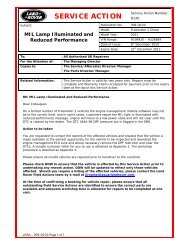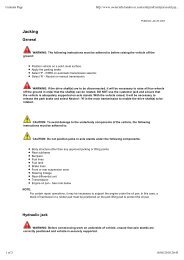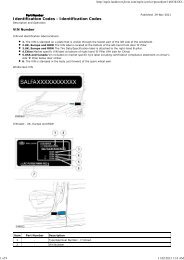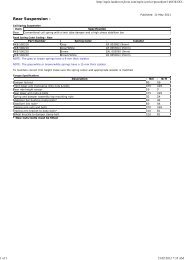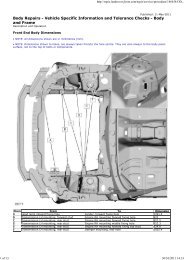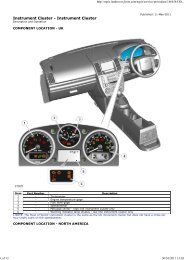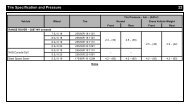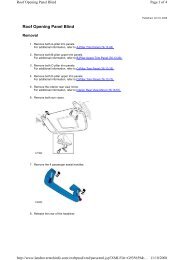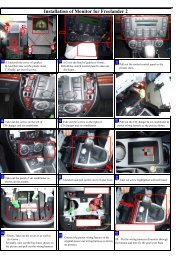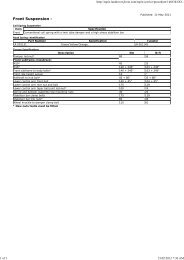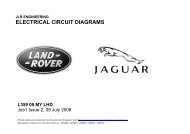Tiguan Haldex All-Wheel Drive - Freel2.com
Tiguan Haldex All-Wheel Drive - Freel2.com
Tiguan Haldex All-Wheel Drive - Freel2.com
- No tags were found...
You also want an ePaper? Increase the reach of your titles
YUMPU automatically turns print PDFs into web optimized ePapers that Google loves.
Page intentionally left blank
IntroductionIntroductionVolkswagen has used a <strong>Haldex</strong> clutch for the4MOTION all-wheel drive since 1998. A newgeneration of the all-wheel drive clutch is now usedby Volkswagen for the first time in the <strong>Tiguan</strong>.The new all-wheel drive clutch is controlledelectronically. It allows torque to be transmitted tothe drive wheels that have traction regardless ofslip at other wheels. The distribution of the driveforces to the axles is variable and depends on thedriving conditions. The new all-wheel drive clutch in4MOTION responds rapidly to any driving situationand maintains the best possible traction at all times.S414_002
OverviewOverviewHistoryIn 1998, 4MOTION drive replaced synchro all-wheeldrive at Volkswagen. While the synchro all-wheeldrive used a visco clutch, an all-wheel clutch by<strong>Haldex</strong> was used for the first time in the 4MOTIONdrive.First Generation <strong>Haldex</strong> ClutchWith this hydraulic multiplate clutch, the all-wheeldrive could be controlled electronically. Apart fromslip control, the control module also allowed handlingdynamic driving conditions such as curves, speed,and overrun, or load operation.Function of <strong>Haldex</strong> ClutchesThe first two generations of the <strong>Haldex</strong> clutch usea rotational speed difference between the front andrear axles to operate. A pump effect is generatedusing a cam plate, rollers, and two reciprocatingpistons working in parallel. This creates oil pressurethat compresses the multiplate clutch througha working piston. The drive torque transferreddetermines the amount of pressure applied.Generation II <strong>Haldex</strong> Clutch from Model Year 2004S414_003The pressure on the multiplate disks of the clutch isregulated through:• Suction valves• Pressure valves• Electronic control valve• Control moduleS414_004
Overview<strong>Haldex</strong> Generation IV<strong>All</strong>-<strong>Wheel</strong> <strong>Drive</strong> ClutchThe power transfer through the multiplate pack ofthe generation IV all-wheel drive clutch is nearlyidentical to the previous <strong>Haldex</strong> models. Generatingthe pressure with an electric pump is a new feature.The torque to be transferred is determined by <strong>All</strong><strong>Wheel</strong> <strong>Drive</strong> Control Module J492 through theselection of <strong>Haldex</strong> Clutch Control Valve N373. Speeddifferences between the front and rear axles are nolonger a prerequisite for activating the all-wheel driveclutch.Advantages• Clutch selection independent from the drivingsituation• Rapid torque build-up• Permanent rear wheel drive capacity• Unrestricted compatibility with the slip controlsystems (e.g. ESP, ABS)Technical Features• Electro-hydraulically controlled multiplate clutch• Integrated in the rear axle drive• Simplified hydraulic circuit• Optimized demand-controlled pump selectionS414_005
<strong>Drive</strong>train<strong>Drive</strong>train4MOTION <strong>Drive</strong>train SystemThe front wheels are conventionally driven by thefront axle differential. At the same time, the torque istransferred to the propeller shaft by this differentialthrough the angle transmission.Depending on the degree of engagement of the allwheeldrive clutch, a torque that matches the drivingsituation is transmitted to the rear axle drive.EngineAngle TransmissionPropeller ShaftRear Axle <strong>Drive</strong><strong>All</strong>-<strong>Wheel</strong> <strong>Drive</strong> ClutchTransmissionFront Axle DifferentialRear Axle DifferentialS414_007
<strong>Drive</strong>trainAngle TransmissionThe angle transmission increases the torque to thepropeller shaft by a factor of 1.6. The diameter of theshaft can be smaller for this reason, since it transfersa smaller torque. In the rear axle drive, the torque isreduced again by the same factor of 1.6.Output toRight <strong>Wheel</strong><strong>Drive</strong> from Transmissionand Output to Left <strong>Wheel</strong>Output toPropeller ShaftPower FlowS414_008The force is transferred from the spur gear tothe propeller shaft by the differential cage of thedifferential, the hollow shaft with crown wheel, andthe pinion.FromTransmissionDifferential CageHollow ShaftOutput toLeft <strong>Wheel</strong>Output toRight <strong>Wheel</strong>Spur Gear Pinion Crown <strong>Wheel</strong>Output toPropeller ShaftS414_009
<strong>Drive</strong>trainPropeller ShaftThe propeller shaft has two parts. They are linkedby a center joint. Flexible disk joints are used tomake the connection to the transfer case and theall-wheel drive clutch. A rotational vibration absorberis permanently attached to the rear flexible disk jointand cannot be serviced separately. It reduces thetransfer of engine vibrations through the rear axledifferential to the body.Center JointFlexibleDisk JointFlexible Disk Jointwith RotationalVibration AbsorberDirection of TravelRear Flexible Disk JointCenter JointS414_010The rear axle transmission and the propeller shaftare balanced during production. For this reason thedrivetrain does not require balancing in the vehicle.The center joint is press-fitted and cannot beseparated. This results in a compact and light designand the roll bellows is better protected.RotationalVibrationAbsorberNo BalancingRequiredRoll BellowsS414_011S414_012
<strong>Drive</strong>trainRear Axle <strong>Drive</strong>The all-wheel drive clutch is integrated in the rearaxle drive.Rear Axle <strong>Drive</strong> PinionCrown <strong>Wheel</strong><strong>All</strong>-<strong>Wheel</strong> <strong>Drive</strong> ClutchMultiplate PackRear Axle Differential<strong>Drive</strong> Shaft<strong>All</strong>-<strong>Wheel</strong> <strong>Drive</strong>Clutch Oil Reservoir<strong>All</strong> <strong>Wheel</strong> <strong>Drive</strong>Control Module J492S414_013
<strong>Drive</strong>trainFunction of the <strong>All</strong>-<strong>Wheel</strong><strong>Drive</strong> ClutchThe all-wheel drive clutch between front and rearaxle drives controls the drive torque to the rear axle.Depending on the degree of engagement, the allwheeldrive clutch directs the required drive torqueto the rear axle.<strong>All</strong>-<strong>Wheel</strong> <strong>Drive</strong> Clutch ComponentsAccumulatorMultiplate PackOil Filter<strong>Haldex</strong> ClutchPump V181<strong>Haldex</strong> ClutchControl Valve N373Oil Circuit ComponentsMultiplate Clutch<strong>All</strong> <strong>Wheel</strong> <strong>Drive</strong>Control Module J492S 414_014<strong>Haldex</strong> ClutchControl Valve N373<strong>All</strong> <strong>Wheel</strong> <strong>Drive</strong>Control Module J492Accumulator<strong>Haldex</strong> ClutchPump V181S414_064
<strong>All</strong>-<strong>Wheel</strong> <strong>Drive</strong> Clutch Details<strong>All</strong>-<strong>Wheel</strong> <strong>Drive</strong> Clutch DetailsOverviewThe individual all-wheel drive clutch componentgroups are shown here to provide a betterunderstanding of how they work.Spring PlateMechanical AssemblyNeedle BearingThrust PlatesWorking PistonsNeedleBearing<strong>Drive</strong> HubMultiplate PackClutch CageElectro-Hydraulic Assembly and <strong>All</strong> <strong>Wheel</strong> <strong>Drive</strong>Control Module J492S414_015<strong>All</strong> <strong>Wheel</strong><strong>Drive</strong> ControlModule J492<strong>Haldex</strong> ClutchControl Valve N373Accumulator<strong>Haldex</strong> Clutch Pump V181Oil FilterS414_040
<strong>All</strong>-<strong>Wheel</strong> <strong>Drive</strong> Clutch DetailsMechanical AssemblyThe following sub-groups belong to the mechanicalassembly:• Multiplate clutch• Working piston• Spring plateThe entire assembly creates the frictional connectionbetween front and rear axles. The multiplate packis compressed when pressure is applied to theworking piston. Depending on the contact pressure,a different torque (up to 1770 lbs-ft or 2400 Nm) canbe transferred.Multiplate ClutchThe multiplate clutch consists of the drive hub, themultiplate pack and the clutch cage.Multiplate PackThe multiplate pack consists of friction plates andsteel plates, with one thrust plate in the front andone in the rear.The friction plates have internal teeth that engage thedrive hub. The steel plates engage the clutch cagewith external teeth. The number of plates dependson the vehicle type.FrictionPlateSteel Plate<strong>Drive</strong> HubThe drive hub is driven by the propeller shaft via theflange.ThrustPlateS414_042Thrust PlateS414_041FromPropellerShaftMultiplate PackS414_052<strong>Drive</strong> HubS414_05110
<strong>All</strong>-<strong>Wheel</strong> <strong>Drive</strong> Clutch DetailsClutch CageThe clutch cage is connected with the pinion of therear axle by a spline, and transfers the drive torque tothe rear axle.Rear Axle PinionClutch CageS414_053SplinesS414_043Working PistonThe working piston is a cylindrical piston.FunctionWhen actuating the clutch, the pressure of theworking piston is transferred to the multiplate packvia a needle bearing. The working piston does notturn. The multiplate pack, on the other hand, rotatesat drive speed.NeedleBearingS414_054Working PistonS414_044Spring PlateThe spring plate is located on the oil pressure side ofthe working piston.Spring PlateOil Pressure SideFunctionIt creates a preload which pushes the working pistonin place. This removes the play from the multiplatepack and the needle bearings.S414_045S414_05511
<strong>All</strong>-<strong>Wheel</strong> <strong>Drive</strong> Clutch DetailsElectro-Hydraulic AssemblyThe electro-hydraulic assembly consists of the<strong>Haldex</strong> Clutch Pump V181, the oil filter, theaccumulator, and the <strong>Haldex</strong> Clutch Control ValveN373.<strong>Haldex</strong> Clutch Pump V181The <strong>Haldex</strong> Clutch Pump V181 is a reciprocatingpiston pump and is installed in the lower sectionof the all-wheel drive clutch. It generates the oilpressure. The accumulator in the oil circuit is filledregularly. It is requested by the <strong>All</strong> <strong>Wheel</strong> <strong>Drive</strong>Control Module J492 depending on the demand.Compressed OilIs DischargedS414_046FunctionThe bores of the cylinder housing each contain apiston with a locating pin and a return spring. Withthe help of an angular ball bearing, the piston andlocating pin are moved in stroke fashion when thecylinder housing turns so that oil is drawn in at thebottom and is discharged compressed at the topafter 180 degrees of rotation.Oil IsDrawn InCylinderHousingBallBearingTo AccumulatorEffects of FailureWhen the <strong>Haldex</strong> Clutch Pump V181 fails, oilpressure cannot be generated. Torque is no longertransferred to the rear axle.PistonLocating PinOil FilterFrom OilReservoirReturn SpringS414_022The oil filter is a no-maintenance fleece filter. A checkvalve is integrated in the oil filter housing whichprevents the oil pressure to the <strong>Haldex</strong> Clutch PumpV181 from dropping.12
<strong>All</strong>-<strong>Wheel</strong> <strong>Drive</strong> Clutch DetailsAccumulatorThe compact design of the accumulator includesthree parallel acting springs and is positioned on topof the clutch. It adjusts the oil pressure using springforce and keeps it at 435 psi (30 bar).System without Pressure:The springs of the accumulator are relieved.From Pump to ValveReturn to Oil ReservoirS414_016System with Working Pressure:The pressure chamber is filled by the pump. Thepressure piston is pushed back and the spring isunder tension.Return ChannelPressure PistonPressureChamberReturn to Oil ReservoirReturn ChannelS414_017If the oil pressure exceeds 435 psi (30 bar), thereturn channels become accessible, the pressure inthe direction of the oil reservoir is reduced, and oilreturns to the reservoir.PressureChamberReturntoOil ReservoirReturn ChannelS414_01813
ControlsPressure Buildup at Engine StartWhen the engine is started, <strong>Haldex</strong> Clutch PumpV181 is activated. <strong>Haldex</strong> Clutch Pump V181 isselected as soon as an engine speed of 400 rpm isreached. It delivers oil via the filter to the accumulatoruntil a pressure of 435 psi (30 bar) is reached in theoil circuit. <strong>Haldex</strong> Clutch Control Valve N373 is closedby <strong>All</strong> <strong>Wheel</strong> <strong>Drive</strong> Control Module J492 so that theworking pressure is passed on to the working pistonand the multiplate pack is compressed.through the accumulator. The working pressure issolely controlled through <strong>Haldex</strong> Clutch Control ValveN373, which can adjust the contact pressure on theworking piston according to the demand.This working pressure may lie between 0%, such aswhen braking, and 100%, as when accelerating.Controlled Working PressureStartingWhen starting to drive and when accelerating, theentire rear axle drive torque is immediately available.DrivingIn each driving situation, the pressure betweenpump and valve is kept constant at 435 psi (30 bar)Oil Pressure0 – 435 psi (0 – 30 bar)S414_029Working Piston<strong>Haldex</strong> ClutchControl Valve N373Oil Pressure 0 – 435 psi (0 – 30 bar)Spring PlateOil Pressure435 psi (30 bar)AccumulatorReturnMultiplate ClutchOil Filter<strong>All</strong> <strong>Wheel</strong><strong>Drive</strong> ControlModule J492Oil ReservoirStrainer<strong>Haldex</strong> ClutchPump V181S414_02818
ControlsDriving ScenariosStarting or AcceleratingA high drive torque is required at the rear axle. Thevalve closes completely and the contact pressure canreach its maximum.<strong>Drive</strong> Torque at the Rear Axle100%Control RangeFast DrivingOnly a low torque is required at the rear axle. Thecontact pressure is controlled according to demand(control range).0%100%Starting/AcceleratingS414_056SS414_032BrakingNo torque is transferred to the rear axle whenbraking. The valve is opened and the pressure on theworking piston is reduced. The clutch is disengaged.0%100%Control RangeFast DrivingS414_057S414_033StoppingThe clutch is disengaged as long as the vehicle isbeing braked. When the vehicle is stopped, the precontroluses the signal from the accelerator position.When starting to drive, the pressure is built up againand full torque capacity is available.Parking ManeuversOnly a low torque is transferred during parkingmaneuvers. The drivetrain is not under tension. Theclutch is controlled according to demand (controlrange).0%Braking100%0%Stopping100%S414_058S414_059Control Range0%Parking ManeuversS414_057S414_049S414_034S414_03519
ControlsCritical Driving SituationsDriving on Slippery RoadsThe working pressure is controlled according todemand.Signals come from ABS Control Module J104, whichdetects slippage through the speed sensors andcalculates the required traction.<strong>Drive</strong> Torque at the Rear Axle100%Control RangeESP or ABS InterventionWhen a wheel slip control system is activated, theamount of clutch engagement is controlled indirectlythrough the ABS Control Module J104. For example,the clutch may be disengaged entirely for an ABSintervention while it can be engaged for an ESPintervention.0%Driving on Slippery RoadsESP or ABS InterventionS414_060S414_036Starting with Slip (On Ice or Snow)The all-wheel clutch is engaged when both wheelsof the front axle spin. The rear axle takes on all of thedrive force.S414_065S414_038If only one wheel of the front axle spins, theElectronic Differential Lock (EDL) becomes active.The spinning wheel is braked and the drive force ofthe other wheel is increased. At the same time theall-wheel drive clutch is engaged and a large portionof the drive force is transferred to the rear axle.S414_06220
ControlsSystem OverviewSensorsActuatorsEngine Speed(RPM) Sensor G28Engine ControlModule (ECM) J623Throttle Position (TP)Sensor G79ABS <strong>Wheel</strong> SpeedSensorS G44-G47<strong>Drive</strong> CAN Data Bus<strong>All</strong> <strong>Wheel</strong><strong>Drive</strong> ControlModule J492<strong>Haldex</strong> ClutchControl Valve N373ABS ControlModule J104Brake Light Switch F<strong>Haldex</strong> ClutchPump V181Electro-Mechanical ParkingBrake Control Module J540Data Bus On BoardDiagnostic Interface J533Steering Angle Sensor G85A sensor cluster is integratedin Electro-Mechanical ParkingBrake Control Module J540. Itcontains the sensors for lateralacceleration, longitudinalacceleration, and yaw rate.S414_02621
ControlsFunctional Diagram30J540J104J623SG85N373J492V18131G85 Steering Angle SensorJ104 ABS Control ModuleJ492 <strong>All</strong> <strong>Wheel</strong> <strong>Drive</strong> Control ModuleJ540 Electro-Mechanical Parking Brake Control ModuleJ623 Engine Control ModuleN373 <strong>Haldex</strong> Clutch Control ValveS FuseV181 <strong>Haldex</strong> Clutch PumpColor CodingPositiveGroundCAN Data Bus LineS414_04722
ServiceServiceTesting Individual ComponentsIndividual component tests can be called throughfunction and component selections in Guided FaultFinding.Guided Fault FindingVOLKSWAGENFunction/Component selectionSelect function or component+ Chassis+ <strong>All</strong>-wheel drive with <strong>Haldex</strong> clutch (4th generation)+ 01 - Systems capable of self-diagnostics+ Electrical componentsG79 - Throttle Position SensorJ492 - <strong>All</strong> <strong>Wheel</strong> <strong>Drive</strong> Control ModuleN373 - <strong>Haldex</strong> Clutch Control ValveV181 - <strong>Haldex</strong> Clutch PumpMode Enter PrintS414_069<strong>All</strong> <strong>Wheel</strong> <strong>Drive</strong> Control Module J492 Self-Diagnostics<strong>All</strong> <strong>Wheel</strong> <strong>Drive</strong> Control Module J492 has theaddress word 22 for self-diagnostics.The all-wheel drive clutch can bereplaced separately.Elaborate adjustment activities afterreplacement are no longer necessarybecause the pinion is part of the rear axletransmission and is not replaced.High-performance oil was developedespecially for the requirements of thegeneration VI all-wheel drive clutch.23
Notes24
Knowledge AssessmentKnowledge AssessmentAn on-line Knowledge Assessment (exam) is available for this Self-Study Program.The Knowledge Assessment may or may not be required for Certification.You can find this Knowledge Assessment at:www.vwwebsource.comFor Assistance, please call:Volkswagen AcademyCertification Program Headquarters1-877-491-4838(8:00 a.m. to 8:00 p.m. EST)Or, E-Mail:concierge@volkswagenacademy.com25
Volkswagen of America, Inc.3800 Hamlin RoadAuburn Hills, MI 48326Printed in the U.S.A.March 2008


